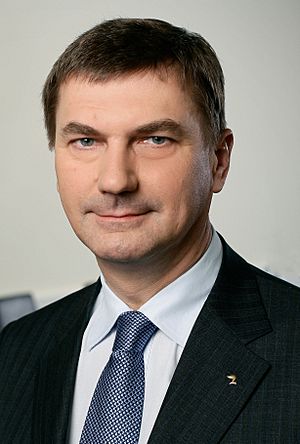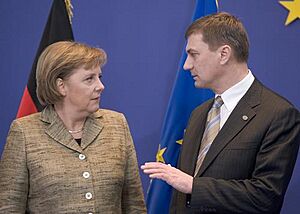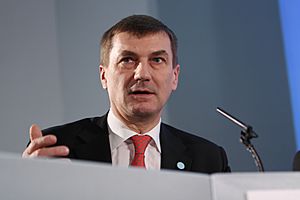Andrus Ansip facts for kids
Quick facts for kids
Andrus Ansip
|
|
|---|---|

Ansip in 2012
|
|
| Member of the European Parliament for Estonia |
|
| Assumed office 2 July 2019 |
|
| European Commissioner for Digital Single Market | |
| In office 1 November 2014 – 1 July 2019 |
|
| President | Jean-Claude Juncker |
| Preceded by | Neelie Kroes (Digital Agenda) |
| Succeeded by | Maroš Šefčovič (Acting) |
| European Commissioner for Digital Economy and Society Acting |
|
| In office 1 January 2017 – 7 July 2017 |
|
| President | Jean-Claude Juncker |
| Preceded by | Günther Oettinger |
| Succeeded by | Mariya Gabriel |
| 16th Prime Minister of Estonia | |
| In office 12 April 2005 – 26 March 2014 |
|
| President | Arnold Rüütel Toomas Hendrik Ilves |
| Preceded by | Juhan Parts |
| Succeeded by | Taavi Rõivas |
| Minister of Economic Affairs and Communications | |
| In office 23 September 2004 – 12 April 2005 |
|
| Prime Minister | Juhan Parts |
| Preceded by | Meelis Atonen |
| Succeeded by | Edgar Savisaar |
| Mayor of Tartu | |
| In office 10 September 1998 – 23 September 2004 |
|
| Preceded by | Roman Mugur |
| Succeeded by | Laine Randjärv |
| Personal details | |
| Born | 1 October 1956 Tartu, Estonia |
| Political party | Reform Party |
| Spouse | Anu Ansip |
| Children | 3 |
| Alma mater | University of Tartu Estonian University of Life Sciences |
| Signature | |
Andrus Ansip (born on October 1, 1956) is an Estonian politician. He is a member of the European Parliament. From 2014 to 2019, he served as the European Commissioner for the Digital Single Market and Vice President of the European Commission. Before that, he was the Prime Minister of Estonia from 2005 to 2014. He also led the Estonian Reform Party from 2004 to 2014.
Before becoming a politician, Ansip studied chemistry. He then worked in banking and business. He joined the Estonian Parliament in 2004. Soon after, he became the Minister of Economic Affairs. In April 2005, he became Prime Minister. On November 1, 2014, he was appointed to the European Commission.
Contents
Early Life and Career Beginnings
Andrus Ansip was born in Tartu, Estonia. He finished his chemistry degree at the University of Tartu in 1979. From 1979 to 1983, he worked as an engineer at the university. He took a two-year break for military service during this time.
Ansip also worked in banking and investment. He was a board member of the People's Bank of Tartu. He also chaired the board of Livonia Privatisation IF. He was the CEO of Investment Fund Broker Ltd. He also served as the chairman of the board for Radio Tartu. From 1989 to 1993, he managed a branch of AS Estkompexim in Tartu.
Political Journey
Serving as Mayor of Tartu
In 1998, Ansip was elected as the Mayor of Tartu. He was a candidate for the centrist-right Reform Party. He held this position until 2004. During his time as mayor, he was very popular. He had run for the Riigikogu, which is the Estonian Parliament, before. However, he always chose to stay as Mayor. Laine Jänes, another member of the Reform Party, took over as mayor after him.
Leading the Reform Party and Economic Affairs
On November 21, 2004, Ansip became the Chairman of the Estonian Reform Party. The party's founder, Siim Kallas, had become an EU Commissioner. This meant Kallas had to move to Brussels. Ansip then had the opportunity to move to Tallinn. The Minister of Economic Affairs and Communications, Meelis Atonen, resigned. Ansip took his place on September 13. His time as Minister was short, so it is harder to see his full impact.
Becoming Prime Minister of Estonia
On March 31, 2005, President Arnold Rüütel asked Ansip to form a new government. This happened after Prime Minister Juhan Parts resigned. Ansip successfully formed a coalition. This group included the Centre Party and the People's Union of Estonia. The Riigikogu approved this coalition on April 12, 2005. Ansip then became the Prime Minister of Estonia. He had the support of 53 out of 101 members of the Riigikogu. He and his ministers officially started their work on April 13.

In the Estonian parliamentary elections on March 4, 2007, Ansip's Reform Party won 27 percent of the votes. This increased their seats in the Riigikogu from 19 to 31. Ansip himself received over 22,500 votes. President Toomas Hendrik Ilves asked him to form a new government. This time, the Reform Party formed a coalition. It included the Union of Pro Patria and Res Publica (IRL) and the Social Democratic Party. His second term as prime minister began on April 5, 2007. In May 2009, the Social Democrats left the government. After talks with the People's Union of Estonia failed, the government continued as a minority government. This meant it was made up only of the Reform Party and IRL.
In March 2011, the Reform Party won 33 seats in the Riigikogu. It remained the largest party. This happened even after Estonia's economy had shrunk by 14% in 2009. This was due to the 2008 financial crisis and a housing market crash. President Toomas Hendrik Ilves again asked Ansip to form a government. The Reform Party continued its coalition with the Union of Pro Patria and Res Publica. Ansip's third term as prime minister began on April 6, 2011. The Riigikogu approved his third cabinet.
However, Ansip's government faced challenges in public opinion. Voters grew tired of years of strict financial policies. There were also some party funding scandals. The opposition parties also became more popular.
On March 4, 2014, Ansip announced he would resign. This allowed a new leader to prepare the party for the 2015 elections. From December 4, 2013, to March 26, 2014, he was the longest-serving prime minister in the European Union.
Role in the European Commission
In the 2014 European elections, Ansip was elected as an MEP. He received the most votes in Estonia. Soon after, Prime Minister Taavi Rõivas nominated him to be Estonia's next European Commissioner.
On September 10, 2014, Jean-Claude Juncker, the President-Elect of the European Commission, announced his proposal. He suggested Andrus Ansip become Vice-President of the European Commission. He also proposed Ansip as the European Commissioner for the Digital Single Market. The European Council formally appointed him with the approval of the European Parliament.
Member of the European Parliament (2019-2024)
Ansip was re-elected in the 2019 European Parliament election. Soon after, he resigned from the European Commission. He took up the seat he won in the European Parliament. Since then, he has served on the Committee on the Internal Market and Consumer Protection. In 2020, he also joined the Committee on Petitions. He also became part of the Special Committee on Artificial Intelligence in a Digital Age.
Ansip is also part of the Parliament's group for relations with the Pan-African Parliament. He is a member of the European Internet Forum. He is also in the European Parliament Intergroup on Artificial Intelligence and Digital. Additionally, he is a member of the European Parliament Intergroup on Seas, Rivers, Islands and Coastal Areas. In March 2024, Ansip announced that he would not run in the 2024 European Parliament election.
Relocation of the Bronze Soldier
One important action of Ansip's government was moving the Bronze Soldier of Tallinn monument. It was moved from a central location in Tallinn to the Defence Forces Cemetery of Tallinn. The monument and war graves were moved on April 27, 2007. This decision led to public discussions and protests.
Personal Life
Andrus Ansip is married to Anu Ansip, who is a gynecologist. They were both born in 1956. They have three daughters. Reet, born in 1977, is a stomatologist (a dentist). Tiina, born in 1981, is a journalist. Liisa was born in 1997.
Andrus Ansip has been a member of the Estonian voluntary home guard organization, Kaitseliit (Defence League), since November 10, 2009.
Awards and Recognition
- On July 31, 2007, Ansip was recognized by the Estonian Central Council in Canada. This was for his "service in the fight for Estonian freedom and the Estonian national idea."
- The Estonian Newspaper Association named Ansip "Press Enemy of 2007."
 Albania: On April 5, 2010, he received a copy of the key to the city of Tirana. This happened during his official visit to Albania.
Albania: On April 5, 2010, he received a copy of the key to the city of Tirana. This happened during his official visit to Albania.
See also
 In Spanish: Andrus Ansip para niños
In Spanish: Andrus Ansip para niños


